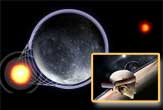For Scientist and Englishwoman, Pluto Mission is Precious - space.com
 By Tariq MalikStaff
By Tariq MalikStaffWriterposted: 23 December 2005
08:45 am ET
It is the first ever flight to Pluto and the first planetary flyby in decades, but for its lead scientist and one Englishwoman NASA’s New Horizon mission will mark a milestone for space exploration.
New Horizons is set to launch on Jan. 17 atop an Atlas 5 booster and begin what is hoped to be a nearly 10-year trip to Pluto, but just getting to the launch pad has been a feat of no small effort.
“If somebody would have come to me 17 years ago and told me what a circuitous route it would take to get to the launch pad, I would have never believed it,” Alan Stern, principal investigator for the New Horizons mission, said in an interview.
The mission also resonates with 87-year-old Epsom, England resident Venetia Burney Phair who, as an 11-year-old girl in 1930, happened to mention to her grandfather that Pluto seemed a reasonable name for the then newly-discovered ninth planet.
“I think it’s marvelous that they can contemplate sending something quite so far away, and so small when you get to it,” Phair said of the mission during a telephone interview. “I only hope nothing goes wrong.”
Discovered in 1930, Pluto orbits the Sun from an average distance of about 3.6 billion miles (5.9 billion kilometers). New Horizons is set to swing past the planet in 2015, if all goes well, and observe the distant world over a five-month period.
Pluto, the harbinger
Budget clashes and funding scrambles have dogged the mission’s long development, but have not tempered its importance for planetary science, according to Stern.
“I call Pluto the harbinger,” he said, adding that the planet was the first hint that large objects sat beyond Neptune. “And then it was found to have a big satellite, so it was the harbinger of giant impacts,” Stern said of Pluto’s moon Charon, which is believed to have originated during a cataclysmic collision.
Pluto marked the first find in the Kuiper Belt – a region icy objects extending out from the orbit of Neptune. In 1988, astronomers discovered its thin atmosphere, with hints of exotic ices, and this year the Hubble Space Telescope picked up signs that Pluto may sport two additional moons, Stern said.
“It really is heralding ahead of its time, over and over again, the richness of what nature did out there,” Stern said.
With the discovery of several new planet hopefuls beyond Pluto, the Kuiper Belt is reshaping long-held beliefs on fundamental planetary science, making it even more imperative to send a probe and see what’s out there, he added.
“We’ve discovered that our entire view [of planets] is wrong,” Stern said. “It’s just joyous to me.”
What’s in a name
Phair, who has followed Pluto’s evolution from planet to ice dwarf to somewhere in-between, said the honor of naming what has become a much-debated planet arose from sheer luck.
The subject came up over breakfast while Phair’s – then Venetia Burney – grandfather read about the new planet in their Oxford, England home, she said.
“I thought in the back of my head, why not call it Pluto,” she said, adding that her class was studying the planets at the time and she had already read about the different Roman gods. “It’s stuck with me all this time, so it must have been a good lesson.”
Phair said her grandfather passed the suggestion Pluto – the Roman god of the underworld – on to Oxford University professor Herbert Hall Turner, and it eventually made its way to Lowell Observatory in Flagstaff, Arizona, where Clyde Tombaugh used to discover the planet in 1930.
“It was extremely lucky,” Phair said. “And it’s been extremely amusing for me to hear from all sorts of people.”
The debate over Pluto’s planethood status, and now over what constitutes a planet in general, has been somewhat amusing for Phair.
“It’s extraordinary,” she said of Pluto. “The more they downgrade it, the more publicity it seems to have. I think the whole mission is very exciting and I’ve always said that I’m lucky to have lived to now to see it.”
Centennial sandwich
For Stern, the timing of New Horizons seems particularly apt.
The probe’s launch window runs mostly between two key dates, beginning with the 100th anniversary of the birth of Gerard Kuiper (Dec. 7) – the Dutch-American astronomer who first postulated that debris from the solar system sat outside Neptune’s orbit. At the other end of the launch window, Feb. 4 to be exact, is the 100th anniversary of the birth of Tombaugh, who discovered Pluto 75 years ago on Feb. 18.
“Here we are with a launch date that perched right between these centennials,” Stern said, adding that family members of both Tombaugh and Kuiper plan to be present for New Horizons’ launch.
“This is really the completion of the initial reconnaissance of the planets, even though we know that most of the planets haven’t been discovered yet,” Stern said. “This is really a marker.”
Pluto-Bound Probe Ready For Long Journey
New Discoveries Await Out on the Horizon
New Horizons: Voyage To The Edge Of The Solar System

0 Comments:
Post a Comment
<< Home